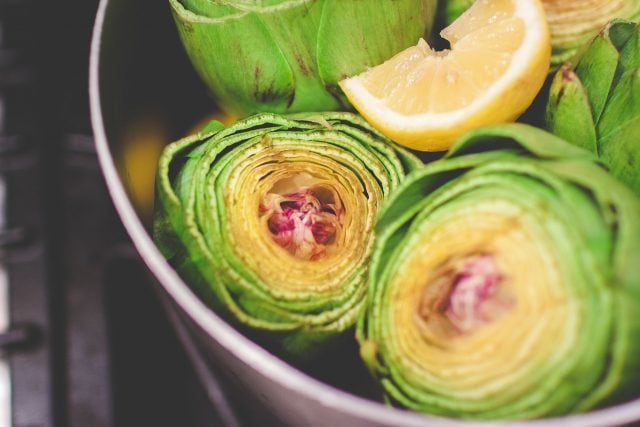Artichokes 101
A ripe, nicely-cooked artichoke is one of my favorite treats. My kids, now grown, loved them even as children. My father-in-law told all of his kids that the ugly bottom center is nasty, and that he’d help them out by eating that part for them. They willingly gave him that part and didn’t discover that he’d defrauded them of innumerable artichoke hearts till they were fully-grown adults! (Parents, this might be worth a try.)
Here’s how to choose a ripe artichoke from the pile at your grocers:
- While the leaves at the base may stick out a little, the top leaves should be tightly overlapped, not open.
- If you hold the stem in one hand and run your other hand up the stem and leaves to the widest point, and squeeze. The leaves should squeak a bit. (Always go from the bottom up to avoid being stabbed by the thorns!)
- An elongated pointy tip, long spikey thorns, a spongy feel, or very rigid leaves are indications that the artichoke is over-ripe. Also avoid fruit with light brown blotches at the base or on the leaves.
- A little frost damage won’t impair their quality. This will look like dark streaks, and they’re okay.
Artichokes are in season January – April and October/November. You can find them year-round nowadays, but the in-season ones will give you the most bang for the buck. Because no, they’re not cheap.
How to prepare an artichoke:
- Cut the stem off at the base. Use a vegetable peeler to peel off the outside layer of the stem. (The stems are almost as tasty as the heart, but most people throw them away!)
- Lay the artichoke sideways on your cutting board, and use a very sharp knife to cut off the top third of the globe.
- This is optional, but safest—use scissors to trim off the pointy tips (where the thorns are) of all the remaining leaves.
Option 1:
- If you want to season them, pry the leaves open and use a grapefruit or other sharpish spoon to scrape out the very center leaves and as much of the furry choke as you can. Put the trimmed artichoke in a saucepan, stem down, in about an inch of water, drizzle the artichoke with olive oil, sprinkle parmesan into the center, sprinkle with coarse salt. Bring the water to a simmer, then cover the pan and let cook for about 40 minutes. It’s done when a leaf pulls free easily.
Option 2:
3b. Boiling can lead to overcooking, which will mess up the buttery taste and texture of the heart. So your second option is to steam them.
- Place the trimmed artichoke top-down in a steamer basket inside a large sauce pan containing an inch or two of room-temperature water. If you’re cooking the stem, throw that into the basked as well.
- Bring to a boil, then cover the pan and lower the heat to medium. Steam it for 25-30 minutes.
How to eat an artichoke:
If you haven’t tried this before, it can seem a little weird. Pull off a leaf, place the inside of the leaf against your bottom front teeth, bite down with your top teeth, and pull the leaf out of your mouth, scraping the “meat” off the leaf with your bottom teeth. Inside leaves will have more meat and less tough leaf part.
Once most of the leaves have been removed, you will be left with a circle of fuzzy yellow stuff. Using a table knife or a spoon, gently scrape off the fuzz. Underneath is a greyish solid but tender base. That’s the heart, and you will want to cut that into bite-sized pieces and just eat them. That’s the stuff that’s good enough to tell a little lie for.
If you want, you can dip the leaves and the pieces of heart in melted butter, mayonnaise, or salad dressing, but don’t overdress them till you’ve tasted them with just a little salt. When the artichoke is really ripe and perfectly cooked, simple is a good thing.






